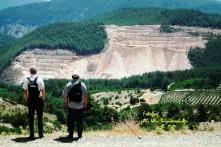
During the last week a short video “went viral” which depicted how several caves in the upper parts of Hasankeyf - an ancient city in the southeast of Turkey - were demolished with dynamite as part of construction work undertaken to erect a large damm.
The first attempt for developing a hydroelectric dam project in the region started as early as 1954 by the State Water Affairs (Devlet Su İşleri, DSI). Throughout the following three decades various feasibility reports were prepared by several national and international consortiums to concretize the project. Finally in 1998 the Turkish Cabinet decided for the construction of the Ilısu Dam over the Tigris River, between the provincial borders of Mardin and Şırnak. The dam construction has been a controversial topic from the very first day, foremost due to the potential destructive threat it embodies particularly for Hasankeyf, the 12.000 years old historical district which will be completely submerged once the construction of the Ilısu dam is finished.
Although Hasankeyf has been declared both an archeological site and a natural reserve in the early 80s by the Turkish parliament, and meets nine out of the ten criteria defined by UNESCO for being defined as “world heritage”, successive Turkish governments never stepped back from accomplishing the project. Despite opposition from environmentalists, expert reports and court decisions that argued for the reverse, the construction has finally started in 2006 with a sod-turning ceremony attended by the then Prime Minister Recep Tayyip Erdoğan. Nevertheless, the construction work did not proceed problem-free. In addition to continuing nationwide opposition from various occupational groups, experts, civil society organizations and artists, who even managed to get court decisions for stopping the construction several times, European credit institutions withdrew their support on the grounds that international credit standards were not met in 2009. Upon the abduction of some construction workers by the PKK in 2014 the construction was interrupted again, this time due to security concerns. Despite all those suspensions however, the construction continued and at the beginning of 2017 the dam even started to retain water.
It came out that the images in the video of last week were part of the fortification work that started in June earlier this year and targeted particularly those caves which apparently were posing danger for the rest of the area. Their destruction was part of a wider project which aims at constructing an artificial “ancient port” on the upper parts of Hasankeyf, for which the risky caves had to be demolished and replaced by concrete walls and caves in good condition had to be strengthened geo-technically. However, after the broadcast of the images, an expert group consisting of geological engineers, civil engineers and architects visited the region and declared that the method in question was simply wrong because it not only demolished risky caves but also damaged solid and secure structures nearby, such as church remnants and wine cellars beneath. The first declaration of Ahmet Deniz, Governor of Batman however was that dynamite was definitely not used in this process. Yet his statement was not successful in becalming the protests. Upon the growing discomfort about the issue, MP Meral Danış Beştaş from the HDP and Sezgin Tanrıkulu from the CHP demanded a parliamentary investigation. The –for now- final protest action came from Mehmet Ali Aslan, a Batman MP from the HDP who chained himself in front of the caves to draw attention to the pillage in the region and stop the destruction.


